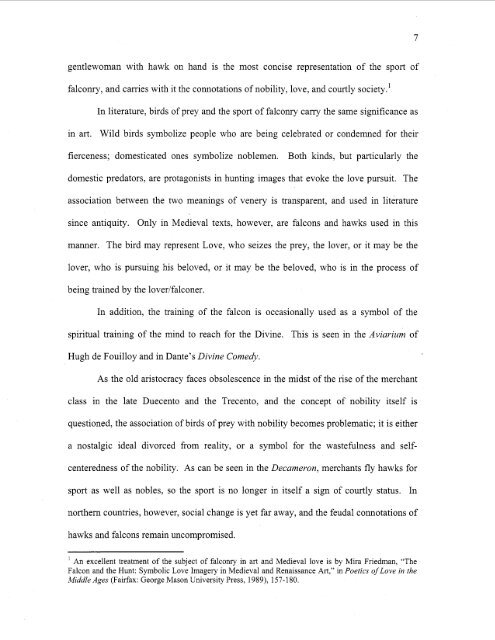Dissertation on Birds of Prey and the Sport - the Falconry Heritage ...
Dissertation on Birds of Prey and the Sport - the Falconry Heritage ...
Dissertation on Birds of Prey and the Sport - the Falconry Heritage ...
Create successful ePaper yourself
Turn your PDF publications into a flip-book with our unique Google optimized e-Paper software.
gentlewoman with hawk <strong>on</strong> h<strong>and</strong> is <strong>the</strong> most c<strong>on</strong>cise representati<strong>on</strong> <strong>of</strong> <strong>the</strong> sport <strong>of</strong><br />
falc<strong>on</strong>ry, <strong>and</strong> carries with it <strong>the</strong> c<strong>on</strong>notati<strong>on</strong>s <strong>of</strong> nobility, love, <strong>and</strong> courtly society.'<br />
In literature, birds <strong>of</strong> prey <strong>and</strong> <strong>the</strong> sport <strong>of</strong> falc<strong>on</strong>ry carry <strong>the</strong> same significance as<br />
in art. Wild birds symbolize people who are being celebrated or c<strong>on</strong>demned for <strong>the</strong>ir<br />
fierceness; domesticated <strong>on</strong>es symbolize noblemen. Both kinds, but particularly <strong>the</strong><br />
domestic predators, are protag<strong>on</strong>ists in hunting images that evoke <strong>the</strong> love pursuit. The<br />
associati<strong>on</strong> between <strong>the</strong> two meanings <strong>of</strong> venery is transparent, <strong>and</strong> used in literature<br />
since antiquity. Only in Medieval texts, however, are falc<strong>on</strong>s <strong>and</strong> hawks used in this<br />
manner. The bird may represent Love, who seizes <strong>the</strong> prey, <strong>the</strong> lover, or it may be <strong>the</strong><br />
lover, who is pursuing his beloved, or it may be <strong>the</strong> beloved, who is in <strong>the</strong> process <strong>of</strong><br />
being trained by <strong>the</strong> lover/falc<strong>on</strong>er.<br />
In additi<strong>on</strong>, <strong>the</strong> training <strong>of</strong> <strong>the</strong> falc<strong>on</strong> is occasi<strong>on</strong>ally used as a symbol <strong>of</strong> <strong>the</strong><br />
spiritual training <strong>of</strong> <strong>the</strong> mind to reach for <strong>the</strong> Divine. This is seen in <strong>the</strong> Aviarium <strong>of</strong><br />
Hugh de Fouilloy <strong>and</strong> in Dante's Divine Comedy.<br />
As <strong>the</strong> old aristocracy faces obsolescence in <strong>the</strong> midst <strong>of</strong> <strong>the</strong> rise <strong>of</strong> <strong>the</strong> merchant<br />
class in <strong>the</strong> late Duecento <strong>and</strong> <strong>the</strong> Trecento, <strong>and</strong> <strong>the</strong> c<strong>on</strong>cept <strong>of</strong> nobility itself is<br />
questi<strong>on</strong>ed, <strong>the</strong> associati<strong>on</strong> <strong>of</strong> birds <strong>of</strong> prey with nobility becomes problematic; it is ei<strong>the</strong>r<br />
a nostalgic ideal divorced from reality, or a symbol for <strong>the</strong> wastefulness <strong>and</strong> self-<br />
centeredness <strong>of</strong> <strong>the</strong> nobility. As can be seen in <strong>the</strong> Decamer<strong>on</strong>, merchants fly hawks for<br />
sport as well as nobles, so <strong>the</strong> sport is no l<strong>on</strong>ger in itself a sign <strong>of</strong> courtly status. In<br />
nor<strong>the</strong>rn countries, however, social change is yet far away, <strong>and</strong> <strong>the</strong> feudal c<strong>on</strong>notati<strong>on</strong>s <strong>of</strong><br />
hawks <strong>and</strong> falc<strong>on</strong>s remain uncompromised.<br />
' An excellent treatment <strong>of</strong> <strong>the</strong> subject <strong>of</strong> falc<strong>on</strong>ry in art <strong>and</strong> Medieval love is by Mira Friedman, "The<br />
Falc<strong>on</strong> <strong>and</strong> <strong>the</strong> Hunt: Symbolic Love Imagery in Medieval <strong>and</strong> Renaissance Art," in Poetics <strong>of</strong>Love in <strong>the</strong><br />
Middle Ages (Fairfax: George Mas<strong>on</strong> University Press, 1989), 157- 180.


